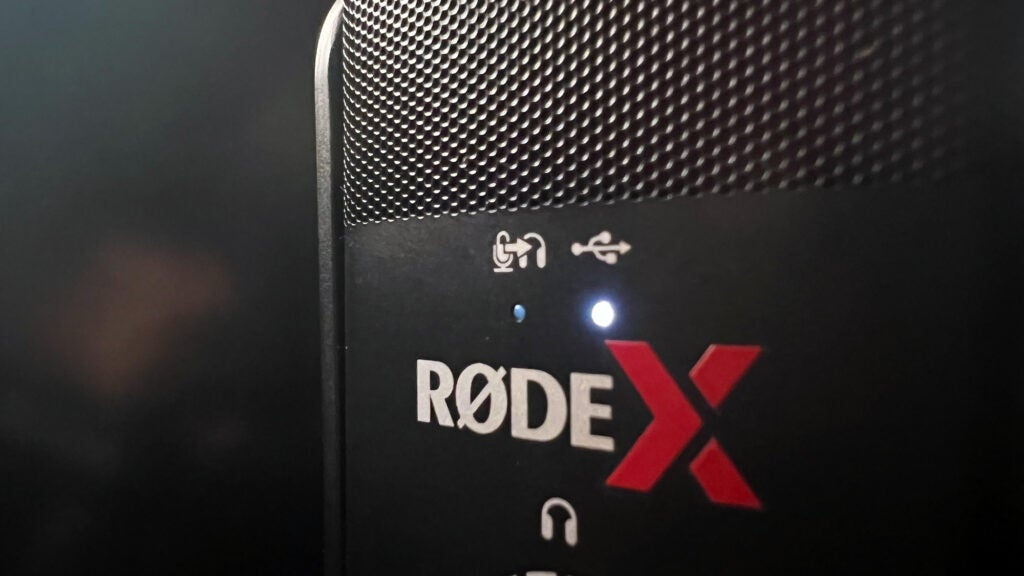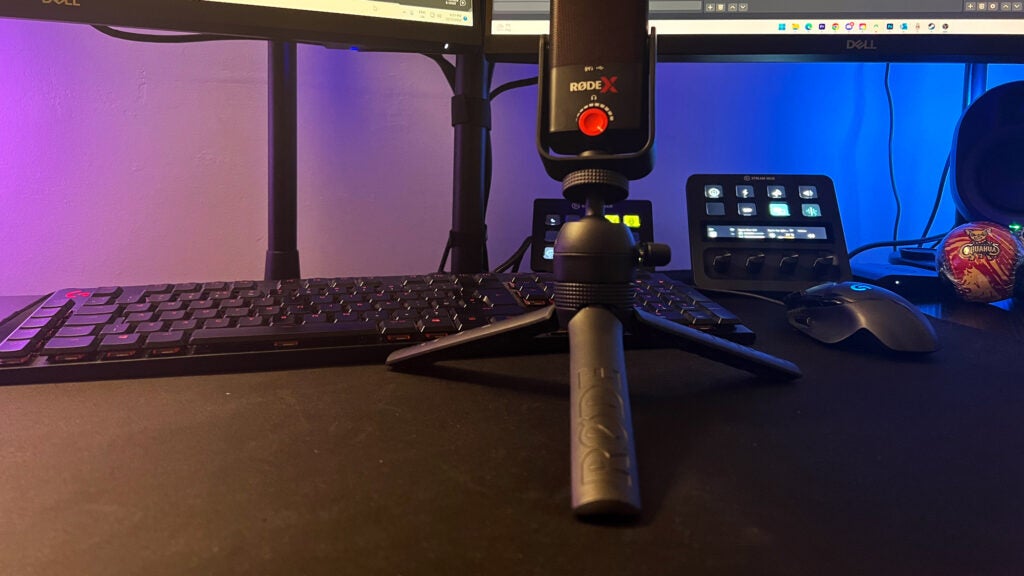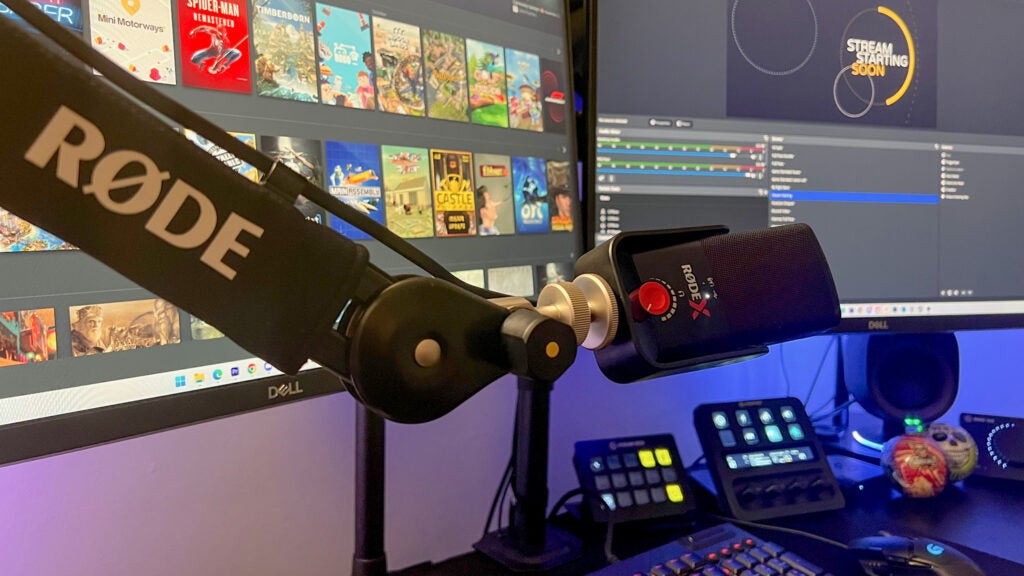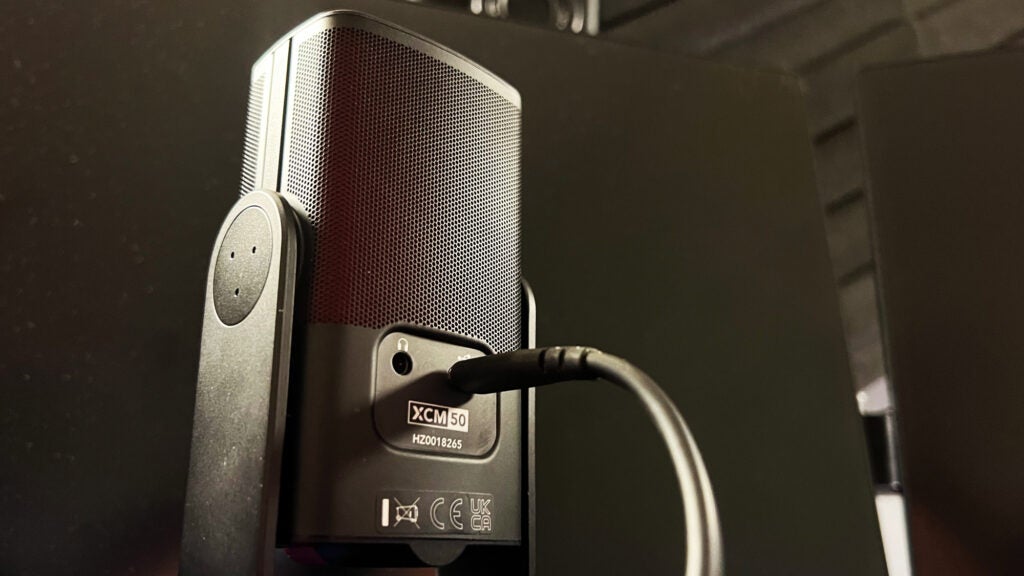Verdict
The Røde X XCM-50 is proof that good things come in small packages. One of Røde’s first dedicated gaming and streaming microphones, this is a little unit that packs a big punch and is a brilliant option for streamers.
Pros
- Clear, natural vocal sound
- Simple USB-C connection
- Incredibly compact design
Cons
- Not a cheap option
- Included tripod needs plenty of desk space
Availability
- UKRRP: £169
- USARRP: $149
-
Typical Røde build qualityAn all-metal body means every part of the XCM-50 feels particularly premium. -
Brilliant vocal performanceAs far as USB microphones go, you’ll be hard pressed to find a better sounding option for vocals. -
Plug and playAn included stand and single USB-C cable is all you need to get started.
Introduction
Take Røde gear but make it for gamers, that’s the concept behind Røde X. The Rode XCM-50 is the first look at what the iconic Australian brand has been working on.
A USB-C condenser microphone, the Røde X XCM-50 promises studio-quality performance at a less-than-studio price point. It’s certainly not a cheap option as far as USB microphones go, so expectations for this streamer-focused mic are high from the outset. Here are my thoughts.
Design
- Rock solid, full metal body
- Impressively small footprint
- Sleek colour scheme
If you’re familiar with the Røde range, the XCM-50 will be a recognisable creature. Close your eyes and picture the NT-USB Mini, now add a little red flair and you’re 90% of the way to a Røde X XCM-50. If you took the logo and tripod away from both, you’d be forgiven for thinking they were different colour options for the same microphone.

That isn’t necessarily a bad thing, as the Røde X XCM-50 offers a pleasant design. It’s a no-frills microphone that, despite its gamer focus, manages to avoid the classic tropes of flashy LED lighting or outrageous shapes.
It’s a little sanded-off rectangle and, without the tripod, the whole unit measures just 11cm long and 6cm wide. That’s a smaller silhouette than an iPhone and, at just 4cm deep, the XCM-50 meets the ‘ultra-compact’ tag Røde X has given it.
As you’d expect from Røde, the build quality on the XCM-50 is top-notch. It’s great to see an all-metal construction at this price and the matte, gently textured body feels like a quality bit of kit. The subtle red hue flowing from behind the grille brings personality and helps bridge the gap between studio and game station.

The attached swing mount lets the Rode XCM-50 spin 360 degrees and offers plenty of flexibility when placed in your setup. It’s a pleasant surprise to find a stand included and the mini tripod feels as well-made as the rest of the peripheral.
It’s nice to have, but I didn’t find the tripod very useful. Its wide footprint demands too much deskspace making it awkward on a normal-sized desk, especially when you factor in a few other streaming peripherals fighting for the same real estate. I’m sure it’ll be fine in plenty of setups, but I kept the XCM-50 on a Røde PSA-1+ mic arm.
It’s a minor thing, but a pat on the back to Rode for their cable inclusions with the XCM-50 too. The USB-C and headphone extension cables both feel high quality and are a whopping three meters long. That’s plenty of cable length to play with and makes a big difference to how easy it is to integrate the XCM-50 into a studio setup.
Performance
- Packs a big punch
- Natural, clean vocal sound
- Picks up more room noise than a dynamic microphone
For such a small microphone, the Røde X XCM-50 is unbelievably strong. It would be easy to look at a mic of this size and assume the output would be just as dinky, but the truth is the opposite.
The XCM-50 punches hard. Before any EQ fiddling, the XCM-50 produced an impressively clean, unreserved sound with pleasantly neutral vocals. This isn’t a microphone with a profile that’s geared heavily towards one kind of creator or another. It’s the mic equivalent of a well-painted white wall. It’s inoffensive, crisp and bright and works in just about any space, but there’s also room for each creator to add their own style on top with an EQ picture frame here and there.

If you’re hunting for that deep, booming late-night radio host vibe, this isn’t the microphone for you. The premium condenser capsule inside the Røde X XCM-50 favours a more natural, less produced sound. It’s also more forgiving on mic etiquette and will maintain quality from a wider range of address angles and distances – perfect for more animated streamers and gamers.
Through testing, I found my voice sounded crisp and clear without ever being harsh or scratchy like you’ll often find with cheaper USB options. There’s a decent amount of space within the sound, though more as a style than a fault, and viewers of my stream commented it felt like they were sitting in the room with me rather than watching an overly produced broadcast.
Features
- Integrated pop filter and capsule shock mount
- Physical, onboard gain control and mute button
- Unify app with Aphex voice processing
The XCM-50 is capable of some serious power and it’s one of the louder USB microphones around. You’ll find a gain-level control wheel on the front of the XCM-50 and I never had to move this beyond halfway to generate optimal output levels. There’s a physical mute button available too, though I’ve never been a fan of onboard controls as it’ll generally result in an unwanted clunk in your audio as you try to trigger it. Around the back is the XCM-50’s 3.5mm headphone jack for real-time audio monitoring so you’ve got no excuse for forgetting to unmute yourself on stream.

Condenser microphones can be brought undone in unoptimised studio settings, but the Røde X XCM-50 does a good job even with a minimal amount of acoustic treatment. The integrated pop filter works well to fight plosives and desk bumps are minimised thanks to the internal capsule shock mount. The XCM-50’s tight cardioid polar pattern means that unwanted noise like mechanical keyboard clacker or fans didn’t become a distraction. The focus was still well and truly on my voice, even without having to keep the microphone too close to my mouth. If you’re a streamer who prefers a clean look with your microphone off-camera, the XCM-50 is a good choice.
There’s internal Aphex voice processing as standard but, for creators wanting more manual control of their sound profile, Røde has the Unify app. I’m not a huge fan of additional software like this, the six additional virtual audio devices it creates can become a lot to manage and stay on top of, but it’s harmless enough if not a little undercooked for now. The usual band of processing effects like a compressor and high pass filter are available for you to tinker with and they work well. Røde has done an excellent job of the out-of-the-box sound of the XCM-50 however, so the majority of creators probably won’t need to put too much effort in.
Latest deals
Should you buy it?
You want a great natural sound
As a condenser microphone, the Røde X XCM-50 delivers a more natural overall sound instead of an overly produced ‘podcast voice’.
Background noise is a problem
It does an OK job, but the Rode XCM-50 will pick up more general room noise from a wider area than a dynamic microphone option.
Final Thoughts
Røde knows what it’s doing when it comes to microphones and the X XCM-50 is further proof of that. There’s a lot of the NT-USB Mini here and that’s no bad thing. It’s taken a good microphone and added some extra seasoning to make it even better for streamers and content creators.
It’s not the cheapest of USB streaming mics but it hasn’t been priced out of contention either. There’s a strong price-quality balance to the Røde X XCM-50 that should make it an appealing prospect to first-time streamers or even those looking for an upgrade. Those willing to spend even more for an added dose of luxury should consider the Logitech Blue Sona.
How we test
During each microphone review, we conduct a series of recording tests that include sampling audio during ideal settings, with background noise applied and in an outdoor setting (where possible), to give you the best idea of how each device performs in real-world use.
Performance tested in a variety of conditions
Tested all available features
FAQs
XLR microphones are the industry standard when it comes to broadcasting, streaming and the like. Quality is paramount with XLR. However, USB microphones continue to improve and typically come in at a cheaper price.
Verdict
The Røde X XCM-50 is proof that good things come in small packages. One of Røde’s first dedicated gaming and streaming microphones, this is a little unit that packs a big punch and is a brilliant option for streamers.
Pros
- Clear, natural vocal sound
- Simple USB-C connection
- Incredibly compact design
Cons
- Not a cheap option
- Included tripod needs plenty of desk space
Availability
- UKRRP: £169
- USARRP: $149
-
Typical Røde build qualityAn all-metal body means every part of the XCM-50 feels particularly premium. -
Brilliant vocal performanceAs far as USB microphones go, you’ll be hard pressed to find a better sounding option for vocals. -
Plug and playAn included stand and single USB-C cable is all you need to get started.
Introduction
Take Røde gear but make it for gamers, that’s the concept behind Røde X. The Rode XCM-50 is the first look at what the iconic Australian brand has been working on.
A USB-C condenser microphone, the Røde X XCM-50 promises studio-quality performance at a less-than-studio price point. It’s certainly not a cheap option as far as USB microphones go, so expectations for this streamer-focused mic are high from the outset. Here are my thoughts.
Design
- Rock solid, full metal body
- Impressively small footprint
- Sleek colour scheme
If you’re familiar with the Røde range, the XCM-50 will be a recognisable creature. Close your eyes and picture the NT-USB Mini, now add a little red flair and you’re 90% of the way to a Røde X XCM-50. If you took the logo and tripod away from both, you’d be forgiven for thinking they were different colour options for the same microphone.

That isn’t necessarily a bad thing, as the Røde X XCM-50 offers a pleasant design. It’s a no-frills microphone that, despite its gamer focus, manages to avoid the classic tropes of flashy LED lighting or outrageous shapes.
It’s a little sanded-off rectangle and, without the tripod, the whole unit measures just 11cm long and 6cm wide. That’s a smaller silhouette than an iPhone and, at just 4cm deep, the XCM-50 meets the ‘ultra-compact’ tag Røde X has given it.
As you’d expect from Røde, the build quality on the XCM-50 is top-notch. It’s great to see an all-metal construction at this price and the matte, gently textured body feels like a quality bit of kit. The subtle red hue flowing from behind the grille brings personality and helps bridge the gap between studio and game station.

The attached swing mount lets the Rode XCM-50 spin 360 degrees and offers plenty of flexibility when placed in your setup. It’s a pleasant surprise to find a stand included and the mini tripod feels as well-made as the rest of the peripheral.
It’s nice to have, but I didn’t find the tripod very useful. Its wide footprint demands too much deskspace making it awkward on a normal-sized desk, especially when you factor in a few other streaming peripherals fighting for the same real estate. I’m sure it’ll be fine in plenty of setups, but I kept the XCM-50 on a Røde PSA-1+ mic arm.
It’s a minor thing, but a pat on the back to Rode for their cable inclusions with the XCM-50 too. The USB-C and headphone extension cables both feel high quality and are a whopping three meters long. That’s plenty of cable length to play with and makes a big difference to how easy it is to integrate the XCM-50 into a studio setup.
Performance
- Packs a big punch
- Natural, clean vocal sound
- Picks up more room noise than a dynamic microphone
For such a small microphone, the Røde X XCM-50 is unbelievably strong. It would be easy to look at a mic of this size and assume the output would be just as dinky, but the truth is the opposite.
The XCM-50 punches hard. Before any EQ fiddling, the XCM-50 produced an impressively clean, unreserved sound with pleasantly neutral vocals. This isn’t a microphone with a profile that’s geared heavily towards one kind of creator or another. It’s the mic equivalent of a well-painted white wall. It’s inoffensive, crisp and bright and works in just about any space, but there’s also room for each creator to add their own style on top with an EQ picture frame here and there.

If you’re hunting for that deep, booming late-night radio host vibe, this isn’t the microphone for you. The premium condenser capsule inside the Røde X XCM-50 favours a more natural, less produced sound. It’s also more forgiving on mic etiquette and will maintain quality from a wider range of address angles and distances – perfect for more animated streamers and gamers.
Through testing, I found my voice sounded crisp and clear without ever being harsh or scratchy like you’ll often find with cheaper USB options. There’s a decent amount of space within the sound, though more as a style than a fault, and viewers of my stream commented it felt like they were sitting in the room with me rather than watching an overly produced broadcast.
Features
- Integrated pop filter and capsule shock mount
- Physical, onboard gain control and mute button
- Unify app with Aphex voice processing
The XCM-50 is capable of some serious power and it’s one of the louder USB microphones around. You’ll find a gain-level control wheel on the front of the XCM-50 and I never had to move this beyond halfway to generate optimal output levels. There’s a physical mute button available too, though I’ve never been a fan of onboard controls as it’ll generally result in an unwanted clunk in your audio as you try to trigger it. Around the back is the XCM-50’s 3.5mm headphone jack for real-time audio monitoring so you’ve got no excuse for forgetting to unmute yourself on stream.

Condenser microphones can be brought undone in unoptimised studio settings, but the Røde X XCM-50 does a good job even with a minimal amount of acoustic treatment. The integrated pop filter works well to fight plosives and desk bumps are minimised thanks to the internal capsule shock mount. The XCM-50’s tight cardioid polar pattern means that unwanted noise like mechanical keyboard clacker or fans didn’t become a distraction. The focus was still well and truly on my voice, even without having to keep the microphone too close to my mouth. If you’re a streamer who prefers a clean look with your microphone off-camera, the XCM-50 is a good choice.
There’s internal Aphex voice processing as standard but, for creators wanting more manual control of their sound profile, Røde has the Unify app. I’m not a huge fan of additional software like this, the six additional virtual audio devices it creates can become a lot to manage and stay on top of, but it’s harmless enough if not a little undercooked for now. The usual band of processing effects like a compressor and high pass filter are available for you to tinker with and they work well. Røde has done an excellent job of the out-of-the-box sound of the XCM-50 however, so the majority of creators probably won’t need to put too much effort in.
Latest deals
Should you buy it?
You want a great natural sound
As a condenser microphone, the Røde X XCM-50 delivers a more natural overall sound instead of an overly produced ‘podcast voice’.
Background noise is a problem
It does an OK job, but the Rode XCM-50 will pick up more general room noise from a wider area than a dynamic microphone option.
Final Thoughts
Røde knows what it’s doing when it comes to microphones and the X XCM-50 is further proof of that. There’s a lot of the NT-USB Mini here and that’s no bad thing. It’s taken a good microphone and added some extra seasoning to make it even better for streamers and content creators.
It’s not the cheapest of USB streaming mics but it hasn’t been priced out of contention either. There’s a strong price-quality balance to the Røde X XCM-50 that should make it an appealing prospect to first-time streamers or even those looking for an upgrade. Those willing to spend even more for an added dose of luxury should consider the Logitech Blue Sona.
How we test
During each microphone review, we conduct a series of recording tests that include sampling audio during ideal settings, with background noise applied and in an outdoor setting (where possible), to give you the best idea of how each device performs in real-world use.
Performance tested in a variety of conditions
Tested all available features
FAQs
XLR microphones are the industry standard when it comes to broadcasting, streaming and the like. Quality is paramount with XLR. However, USB microphones continue to improve and typically come in at a cheaper price.
























